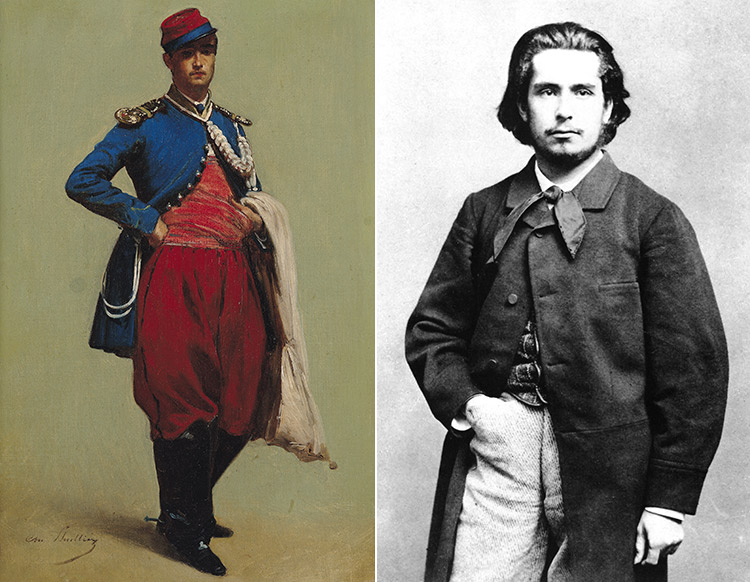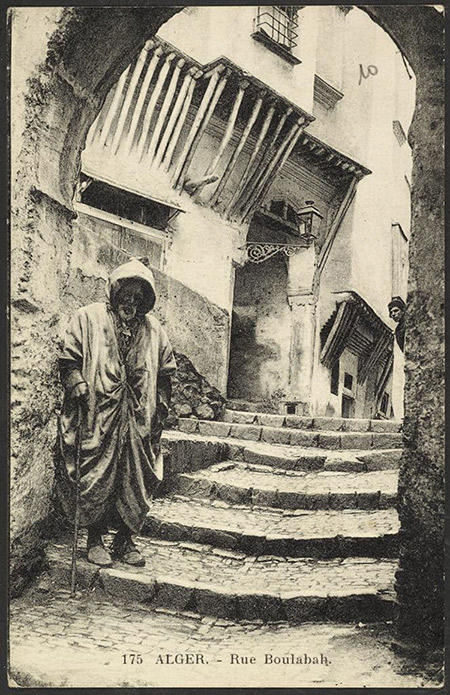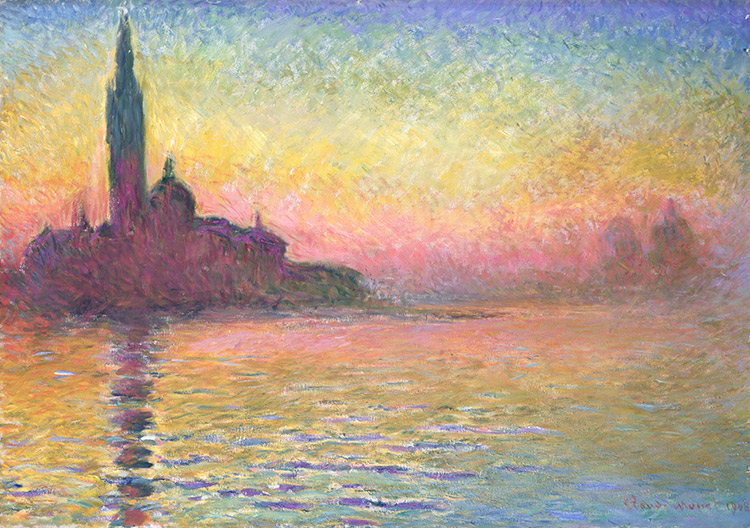Monet in Algeria
The painter Claude Monet spent his early twenties as a soldier in French North Africa, yet none of his works or writings from this period survive.
 Claude Monet, a 20-year-old art student, appeared in the sub-prefect's office in his home town, Le Havre, on March 2nd, 1861 along with 227 eligible young men. They arrived to draw a lottery number for the compulsory army draft; Monet drew a low number, below 74, and was called into service. His father, a prosperous ship's chandler, could have bought his son's discharge for 2,500 francs, but he refused to do so when Claude refused to give up painting. Monet's father had an interest in removing him from the local scene: he did not want his son to find out about his mistress and the existence of an illegitimate half-sister. His father also disliked spending money. Most important, he thought military discipline would improve his son's volatile yet stubborn character and make him more amenable to his father's wishes.
Claude Monet, a 20-year-old art student, appeared in the sub-prefect's office in his home town, Le Havre, on March 2nd, 1861 along with 227 eligible young men. They arrived to draw a lottery number for the compulsory army draft; Monet drew a low number, below 74, and was called into service. His father, a prosperous ship's chandler, could have bought his son's discharge for 2,500 francs, but he refused to do so when Claude refused to give up painting. Monet's father had an interest in removing him from the local scene: he did not want his son to find out about his mistress and the existence of an illegitimate half-sister. His father also disliked spending money. Most important, he thought military discipline would improve his son's volatile yet stubborn character and make him more amenable to his father's wishes.
Yet Monet refused to abandon his career as an artist. He thought the picturesque oriental locales painted by his hero Eugène Delacroix were infinitely more appealing than a grocery store in Le Havre or an austere barracks in a boring provincial town. He later recalled:
The seven years of service that appalled so many were full of attraction for me. A friend, who was in the regiment of the Chasseurs d'Afrique and who adored military life, had communicated to me his enthusiasm and inspired me with his love of adventure. Nothing attracted me so much as the endless cavalcades under the burning sun, the razzias [raids], the crackling of gunpowder, the sabre thrusts, the nights in the desert under a tent, and I replied to my father's ultimatum [to give up art] with a superb gesture of indifference. I drew an unlucky number. I succeeded, by personal insistence, in being drafted into an African regiment and started out.
Monet's experience in North Africa certainly toughened him up and prepared him for his future arduous painting expeditions in intense cold, high wind and severe storms. In defying his overbearing father, he finally broke away from emotional and financial domination.
Monet was inducted into the army on April 29th and swore to serve with honour and fidelity for seven years, a period that would be dramatically cut short. His military record reveals that his hair and eyes were brown, his nose 'well made', his chin clean-shaven and round, his face oval and his height 1.65 metres (5 ft 5 ins). A bachelor without children, he was physically fit and had never been convicted of theft, swindling, fraud or immoral behaviour. Monet joined the first regiment of the Chasseurs d'Afrique, an elite light cavalry corps that had fought victoriously in Morocco in 1844, in the Crimean War of 1853-6 and in Solferino in northern Italy, where the French had defeated the Austrians in 1859. The Chasseurs, the mounted equivalent of the French Zouave infantry, were first raised in 1832 from cavalry posted to Algeria and from French volunteers in North Africa.
Before the two-day voyage from Marseilles to exotic, mysterious, dangerous Algiers, Monet's friend from Le Havre, Charles Lhuillier, painted his full-length portrait. Monet's new uniform combines European dress and oriental costume. He wears a red and blue képi with a black brim shading his forehead and eyes; a long blue tunic with epaulettes, gold buttons and a hanging yellow lanyard fastened at the collar and opening into a wide pyramid along his legs; billowing red Turkish trousers; and high black boots with spurs. Facing forward with one foot placed in front of the other, Monet assumes a swaggering stance with his rakishly tilted cap, right fist on his hip, left arm holding a long white burnous and hand tucked inside his wide red sash. His dark, thin, idealised figure looks very different from the bearded, stocky, stolid Monet in a photograph of 1860.

No letters or works of art have survived from this major turning point in Monet's life. (Algerian Scene, a landscape with camels painted in the style of Eugène Fromentin, was later destroyed by the artist.) The books about him give only a brief account of his year in Algeria, but by describing the recent events, the contemporary state of Algeria, the North African ambience and his military duties, it is possible to evoke some of Monet's experience during this little known yet influential period.
***
Monet arrived in Algiers on June 10th, 1861, during the Second Empire (1852-70) of Napoleon III. Algeria had until recently been part of the Ottoman Empire, but the weak and corrupt Bey had control only of the cities on the coastal plain. Marauding Barbary pirates dominated the southern Mediterranean, preyed on ships and carried away booty. After a minor diplomatic insult and using the flimsiest excuse for invasion, the French had moved into this power vacuum, capturing Algiers in 1830 and Constantine in 1837. Four years later France had established the Foreign Legion, in which French officers commanded foreigners who volunteered to serve overseas. France had fought a long guerrilla war in the desert with Emir Abd el-Kader, who led the Arab struggle against the colonial invaders until he finally surrendered in 1847. The following year the French officially abolished, but did not extinguish, the widespread practice of slavery. From 1859 to 1861 the French explorer Henri Duveyrier, braving the hostility of the nomadic Tuaregs, penetrated deep into the desert and published his influential L'Exploration du Sahara in 1864. By 1870 French soldiers would reach the edge of the Sahara, which stretched south to Lake Chad and almost to the River Niger.
A bloody episode, which took place only two months before Monet arrived, revealed how vulnerable the French still were. On the night of April 14th, 1861, about 50 Arabs (without guns) attacked Djelfa, 260 miles south of Algiers, one of the last military outposts in the south and the site of a small settlement of European colonists. In A Desert Named Peace (2009), Benjamin Brower wrote:
Armed with staffs, stones and knives, the group slipped past the garrison and descended upon the village, where they raided five houses and a café maure, a local Arabic-style coffeehouse. They attacked with deadly intent, killing three Europeans (two men and a five-year-old girl) and critically wounded three settlers, two labourers and three soldiers. The settlers, belatedly joined by French soldiers, killed four of their attackers, while the leader himself escaped.
This attack was followed by harsh military retribution.
In Monet's time Algiers was populated by Berbers (the original inhabitants), Arabs (who had converted them to Islam) and a remnant of Turks. In The Conquest of the Sahara (1984) Douglas Porch described the physical setting of the city, which rose from the sea to the mountains and the contrast between the modern town and the ancient Casbah:
The Boulevard du Front de Mer, supported by vaulted arches, connected the harbour with the Place du Gouvernement on the bluff above. From there, one could look out over the almost perfect semicircle of the Bay of Algiers filled with small wooden boats and larger steamers … Behind the seafront a multitude of terraces, minarets and houses of startling whiteness climbed the hill until they disappeared into the sombre greenery of the summit. In the narrow, twisting streets of the Arab quarter, merchants sat before pyramids of oranges, sacks of herbs and spices, pieces of raw, dripping meat … The air was permeated with the soft, indefinable odour of an Arab souk, or marketplace. The outline of the Kabylia Mountains, some snowcapped, stood like sentinels above the town. The air seemed to vibrate with sunlight.
In 1860 the traveller Ernest Feydeau emphasised how easily the stranger got lost in the labyrinthine and disorienting Arab section of Algiers, whose houses were crammed together to keep out the harsh sunlight:
Located on the hillside above the French city, or Marine quarter, the Casbah was in reality a multi-ethnic quarter, housing both Jews and West Africans as well as Muslim city dwellers known as Moors. It could be reached from the Marine quarter by climbing a steep hill. Inside the Casbah, narrow streets followed curving paths, guiding the traveller through whitewashed buildings with few openings to the exterior.
Algiers had a high crime rate and loose morals and both civilians and soldiers spent a lot of time in the town's bars and cafés and in the Arab brothels of the Casbah. The louche allure of the Casbah lasted well into the 20th century and was portrayed in many popular films: Morocco (1930); Pépé le Moko (1937); Algiers (1938), with its memorable line: 'Come with me to the casbah'; and Beau Geste (1939).
***

Barely half the recruits to the colonial administration before 1914 had even a secondary education', wrote Porch, 'and 22 per cent were judged incompetent by their immediate superiors'. Nevertheless, they managed with a well-trained and well-armed military force to conquer and control the vast land. Monet, at the very bottom of the military pyramid, was posted to the barracks in the Mustapha quarter at the eastern gate of Algiers and was housed in a one-storey, mud-brick building. He had never mounted a horse and needed extensive training in the riding school, but he finally learned to control a horse and perhaps, with considerably more difficulty, a restive camel.
The soldiers led a strict life during campaigns, but were not subject to severe discipline when they were not fighting. Monet remained on the comparatively safe and temperate coast and there is no evidence that he ever engaged in combat or suffered sandstorms and thirst by penetrating the vast and hostile desert. Monet's friend, Count Théophile Beguin-Billecocq, quoting letters now lost, later recorded that:
He wrote to us often and detailed the harshness of the soldier's life, listing the endless guard duties and fierce instructors he endured, and the veritable nags he was required to ride.
Before the sudden and dramatic conclusion of his military service, Monet had the opportunity to do some drawings and watercolours (also lost) of the old Spanish gate in the casbah of Oran. His officers, bored by garrison duty and eager for immortality, asked Monet to draw their portraits, and his burgeoning and obvious talent gained a few favours and earned some leave.
The monotonous, arduous routine finally drove Monet to a half-mad, fever-inspired breakdown and a wild attempt to escape. He later recalled:
The hours of training seemed so tiresome. It seemed so wearisome to be confined to barracks or camp. [So he mounted a mule and galloped away, but] eventually ran out of breath and fell fainting to the ground. Unburdened of my weight, the mule stopped of its own accord and wandered lazily back to the barracks. A search party found me that evening, unconscious and in a most pitiful state. My uniform was in shreds and my entire body was covered with cuts and bruises. I awoke confined to a cell by orders of the military police and accused of desertion and destruction of military property. The next day, I was taken to prison and I again lost consciousness. I was spared the military tribunal and taken to the hospital, where I was diagnosed as having typhoid fever.
The symptoms of typhoid, a bacterial disease that originates in contaminated food or water, are a pink rash, high temperature, head and muscle aches, stomach pains and constipation. Sick for three weeks, Monet was granted two months rest in Algiers and six months convalescence in Paris.Rescued from an additional five-and-a-half years in the army, he was bought out by his wealthy aunt for 3,000 francs, 500 more than his father could have originally paid.
Many prominent French authors travelled to and wrote about North Africa: Théophile Gautier, Eugène Fromentin, Gustave Flaubert, the Goncourt brothers, Alphonse Daudet and Guy de Maupassant. Writing in his journal from Tangier in 1832, Delacroix, like many 19th- and 20th-century writers, emphasised the palette of colour and light (even in the dark shadows) that would also influence Monet:
As we were coming home, superb landscapes on the right, the Spanish mountains in the softest possible tones; the sea, a dark blue-green, the colour of a fig. The hedges, yellow on top because of the bamboos, green at the bottom because of the aloes … Shadows full of reflections; white in the shadows.
In his novel The Immoralist (1902) André Gide (who met Oscar Wilde in Algiers in 1895) echoed Delacroix and seemed to be describing an Impressionist painting:
The quality of the light here is not strength but abundance. The shade is still full of it. The air itself is like a luminous fluid in which everything is steeped; one bathes, one swims in it.
Forty years later, Albert Camus' Meursault, about to murder an Arab in The Outsider, describes the effect of the trembling Algerian sun, heat and light that had driven Monet half-mad when he had tried to escape:
There was the same red glare as far as the eye could reach, and small waves were lapping the hot sand in little, flurried gasps … I could feel my temples swelling under the impact of the light … I keyed up every nerve to fend off the sun … A blade of vivid light shot upward from a bit of shell or broken glass lying on the sand.
Monet's accounts of his crucial year in Algeria were recorded in two interviews with him, published nearly 40 and 65 years after the events had taken place. Filtered through time and depending on his mood of the moment, the memories of the now old and successful artist revealed the contrast between his expectations and reality, and gave both exaggerated and contradictory recollections of the adventurous and finally disastrous military experiences of his youth.
***
Gide, like Monet himself, also explained how his imagination, stimulated in North Africa, had awakened dormant powers that would later enhance his work: 'At the touch of new sensations, certain portions of me awoke – certain sleeping faculties, which, from not having as yet been used, had kept all their mysterious freshness.' Monet, in a nostalgic 1900 Le Temps interview with François Thiébault-Sisson, recalled the delayed but significant benefits of his experience:
In Algeria, I spent two [sic] really charming years. I incessantly saw something new; in my moments of leisure I attempted to render what I saw. You cannot imagine to what extent I increased my knowledge, and how much my vision gained thereby. I did not quite realise it at first. The impressions of light and colour that I received were not to classify themselves until later; but they contained the germ of my future researches.

Twenty-six years later, the same interviewer in the same journal recorded the youthful idealistic enthusiasm that had propelled Monet into the Chasseurs d'Afrique, which was clearly superior to the infantry:
[Algeria] appealed to my sense of adventure. In any case, the uniform was elegant, which appealed to me even more, and the thought of trotting along on a lively little horse beneath the African sun, with foot soldiers kicking the pebbles along the road as they laboured to carry their packs, did not seem at all disagreeable to me.
Beguin-Billecocq recalled that Monet described Algeria as:
a splendid country with constant sunshine, with hot, seductive colours, an eternally blue sky accentuated by the greens of palms and exotic plants, Arabs and their veiled wives, the Arab language, guttural but beautiful, camels, donkeys and horses.
But in the same 1926 interview Monet also described his fever-driven attempt to escape from these beautiful horses. Unlike his friend Pierre-Auguste Renoir, who was inspired by his two visits to Algeria in the early 1880s, Monet never returned to North Africa. He ended his ambivalent interview of 1926 by unequivocally stating that he was glad 'at never again having to see a country that had left me with so many awful memories'. He contradicted himself yet again by adding: 'I had not even thought of painting for an instant.'
Hugues Le Roux, a French critic writing in Gil Blas in 1889, concluded that for Monet, as for Delacroix:
Africa put the finishing touches to his mastery of colour. It taught him to see into shadow, and follow the brilliant decomposition of light to be found there, to set afloat an atmosphere around objects that trembles and encircles them like a halo.
Though Monet escaped his full term of military service, his year in Algeria was sufficient to absorb the spirit of the place. His experience helped him to mature and confirmed his artistic ambitions; it focused his mind and vision, and inspired the light and colour of his Impressionist work.
Jeffrey Meyers is the author of Painting and the Novel (1975), a biography of Wyndham Lewis (1980), Impressionist Quartet (2005) and Modigliani (2006).